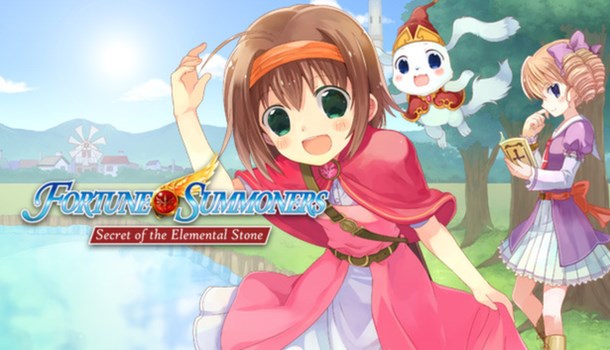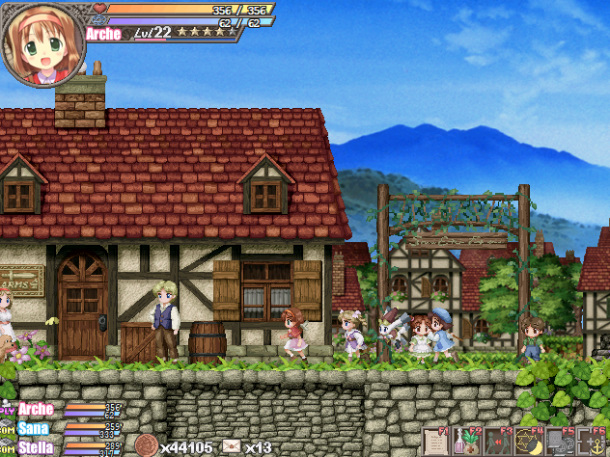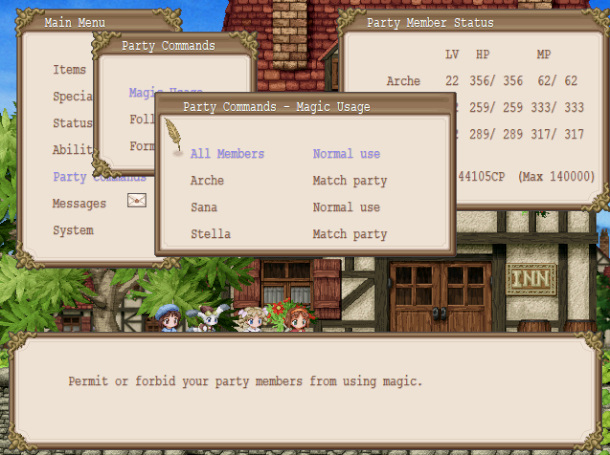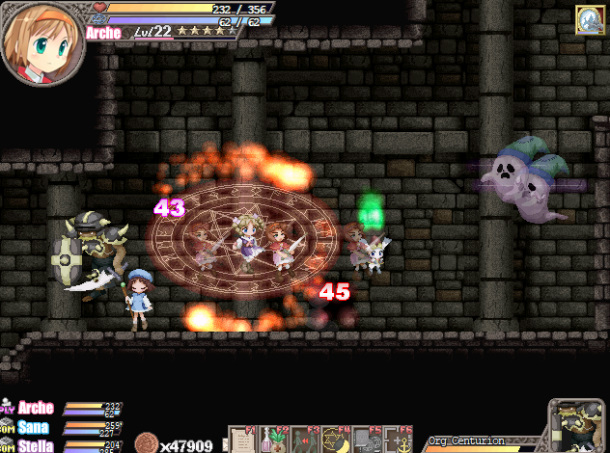
Written by Eoghan O'Connell on 30 Oct 2025
Distributor Carpe Fulgur • Price £12.99
It was by circumstance that I was playing Fortune Summoners: Secret of the Elemental Stone, the third game from translation company and distributor Carpe Fulgur, when I heard that Andrew Dice, one of the founders, had passed away. When I reached the credits, a pang of pain crossed my heart when I saw his name appear, reminding me that he was no longer with us. I never knew the man but I’ll always be thankful for the impact he had. His and Robin Light-Williams’s work on Recettear and its commercial success opened the door to more Japanese games being released for PC. I had completed Recettear when it first came out and managed to get to the final boss of Chantelise before giving up on it but Fortune Summoners was quite different. From a different developer than the previous two titles, the game proved to be too challenging for me and I never even made it past the prologue. This was something that I’d always wanted to rectify and, so, I finally sat down and played through it this year. Considering my previous coverage of Chantelise and the recent news about Andrew Dice, I thought it prudent to write out my thoughts on Fortune Summoners: Secret of the Elemental Stone.
Set in the land of Scotsholm, you play as Arche Plumfield, a young girl who has just moved to the town of Tonkiness with her parents. Her new school deals with magic and, unfortunately for Arche, magic requires the use of an elemental stone, something which she does not have and seems prohibitively expensive for her family. It’s at this point that she learns of a legend from one of her new classmates; an elemental stone has been hidden deep inside a nearby cave filled with dangerous monsters and traps. Together with her new friend, Sana, they set out to find this mysterious stone, only to find that their journey isn’t going to be as simple as it first appears.

The story of Fortune Summoners lands oddly for me as I think it’s enjoyable yet features some bizarre pacing choices. Taking place over the course of eleven days, the plot point of the elemental stone is weighted towards the beginning and end with the middle consisting of character development of Arche and her relationship with the other students, particularly one called Stella. While enjoyable in its own way, I did find myself wondering when we’d return to the elemental stone, a sign that the story was dragging its feet a little. Something else that was of interest to me was that, whenever I tried to look up information about Fortune Summoners, I would see one of the top Google autocomplete suggestions being Fortune Summoners 2. Since I knew that no such game existed, I was curious whether the end of the game would be left open for a sequel. Not only does it do that but it goes so far as to tease a sequel with a narration noting several mysteries that yet remained and finishing with a “The End (...?)” Considering the length of time, I would say the chances of a sequel being released are slim at this point so I can’t say that I got much satisfaction out of this.
As for the characters, they’re decent overall, albeit on the tropey side. Arche is a considerate lead who often acts before she thinks, a clear example of this being her decision to seek out the elemental stone rather than tell her parents about her need for one, an effort which shows concern for her family’s situation, yet fails to realise the danger she’s putting herself and her friend in. There are a few times where she loses her temper but it’s usually only after she’s been provoked in some shape or form. Sana is the first friend she forms in Tonkiness and comes across as a shy girl who has difficulty making friends and spends her time taking care of the school animals. While clearly the least confident of the group and the one most likely to scream in fear, it is touching to see how much she enjoys her newfound friendship with Arche. Stella, the last member of the trio, acts cold towards Arche at points but clearly cares more than she’s letting on. While there are a few baffling moments of agitation between them, her steady integration into the group is nice to see.
In terms of gameplay, Fortune Summoners is a side-scrolling action RPG with platforming elements. The game world contains several towns which offer various services for a price and also contains various dungeons which are key to progressing the story. Combat is real-time and looks deceptively simple at first. Arche is unable to use magic but, thanks to training from her father, she is quite adept at using a sword. This results in her being the tankiest of the trio and the only one specialising in close range combat. Sana is pretty much the opposite, a support mage who mainly deals with healing and buffs but has several offensive spells she can use as well. However, she requires distance to cast her spells, often leading to the player using Arche to occupy their opponents while Sana focuses on casting. Stella is the offensive mage with the vast majority of her spells being highly destructive. Stella is a little more capable than Sana when it comes to enduring attacks and fighting hand-to-hand but she still requires space to achieve her full potential. As far as party compositions go, this is quite a standard one. However, it’s when we get to the combat mechanics themselves that we see some differences.
As the characters level up, more on that later, they steadily gain access to new abilities. For Sana and Stella, this is primarily in the form of new spells which they access through books. In this case, books refer to a group of up to ten spells which the characters are able to quickly access and cycle through. There are three books, A, B and C, which can be assigned spells although AI characters will only access the spells in books A and B. However, Arche’s abilities function quite differently, being more like those from a fighting game with quick, rapid inputs translating into specific attacks. Her abilities can, generally, be enabled or disabled via the menu so that you don’t keep accidentally doing certain attacks.

Speaking of the menu, now is a good time to talk about the customisability in combat. As is often standard with RPGs with AI companions, you are able to set behaviours prior to battle such as magic usage, whether they follow the character currently being controlled and, most interesting to me, the formation which basically dictates how characters are positioned and their distance from each other. I can commend this but, unfortunately, it doesn’t work as neatly as you might hope. Combat is fast-paced and enemies will regularly move through you in an attempt to get past your guard. However, your AI companions often struggle with this, attempting to line up behind you which will often lead to them getting caught up in the melee struggle. Considering their need for space to cast spells and their relative fragility compared to Arche, this will often result in them getting stun-locked and taking tons of damage until you can drive off their attackers.
This isn’t the only frustration you’ll come across either. Movement feels sluggish and slippery. Even near the end of the adventure, I’d find myself sliding off platforms as I tried to adjust myself after landing. Early in the game, you’re highly restricted in resurrecting characters who have fallen in battle and I would often have to make the long, awkward march back to town in order to revive them. This might not be so bad if it wasn’t for the fact that enemies prevent you from moving between screens. You can’t simply rush forward or backwards in a dungeon but have to fight through hordes of enemies every time. Even when you get access to the item that allows you to resurrect your party, you’ll have to struggle with inventory management since, unlike most RPGs, your equipment occupies space even when being used and items hardly ever stack.
When I began the game, I noted that it automatically set the difficulty to easy and I found myself scoffing. “Hah, I’m no casual. I’ll set it to normal.” This might have been okay if it wasn’t for a few reasons. Let’s start with what was a clear and interesting choice on the part of the developer. As I began to get used to the combat system, I noticed that something felt strange. The way enemies moved and responded to my attacks seemed too perfect as responses, jumping just as I swung my weapon or maintaining an exact distance as I tried to close the gap. It took a while but it finally clicked what was happening. Input reading. For those unfamiliar with the term, input reading is when AI reacts to a player’s input, allowing them to respond in unnaturally fast ways. I first noticed this concept in the games of FromSoftware and am okay with their implementation there with a few exceptions in Elden Ring. However, I found the implementation in Fortune Summoners to be exhausting as opponents deftly dodged my strikes and stayed out of my reach. Eventually, I found the best way to handle this was to wait until an enemy was in the middle of an action, perhaps falling after jumping or recovering from attacking, in order to safely attack. This led to battles, particularly since it was rare when I could just run past them, turning into long slogs that drained precious resources that I wanted to save.
You might think to yourself “It’s a JRPG. Just grind a bit and you’ll sweep through those monsters in no time!” While grinding can be feasible at points, it isn’t as effective as you might think. When you start the game, you might notice, assuming you look in your menus, that the max level you can reach is three. That might seem odd but it is explained when you first come across a Mark of Heroism while exploring. Upon attaining a mark, it increases the amount of money you can carry but, more importantly, it also increases your max level by one. Therefore, grinding is heavily restricted unless you find a few in rapid succession. Given that grinding can often trivialise JRPGs, I actually really like this idea but it does mean that it’s rare when you feel powerful.

In terms of technical presentation, this is where we see a very, VERY, mixed bag. To start with, the world of Fortune Summoners is pleasant to look at with detailed pixel art, lovely effects and mostly smooth animation. However, the game suffers severely when it comes to its technical aspects. I have a powerful PC but, however the game was optimised, Fortune Summoners runs abysmally. It’s often tolerable, particularly early in the game, but magic effects cause the framerate to tank, sometimes to what I believe to be single-digit figures! Considering two out of your three party members are mages, this will be something you will increasingly encounter as the game progresses and it’s particularly frustrating when the game fails to register some of your inputs in the midst of battle because of this problem. Controller support also seems strange with an in-game setting implying it but I had to manually configure a setup in Steam Input in order to get mine working. Steam Overlay also failed to work which is a relatively minor problem but it did prove to be another annoyance in my experience.
Voice acting is infrequent and is only in Japanese but it seemed fine the few times that it did appear. Music was quite catchy although perhaps lacking a little variety when stretched to the entire playtime.
I haven’t mentioned this up to this point but I do have a great deal of respect for Fortune Summoners since I learned that this was a one-dev project with only some relatively small contributions in the form of an illustrator and voice actors. Fortune Summoners is an immense and ambitious game and the fact that one person managed to hammer this together over the course of a few years is deeply impressive. Still, this changes little when it comes to the game experience itself which is why I held off on mentioning it to this point. Fortune Summoners is a game that I think would greatly benefit from a remaster, improving technical performance and ironing out some of those design issues. I’m glad that I’ve finished Fortune Summoners after all these years but, as it stands now though, I find it hard to recommend fully with all these problems that eventually add up to a frustrating experience although I can easily see why the game has garnered a cult following.

Going by the online persona Immortallium, I'm a YouTuber as well as a Manga, Anime and Video Game enthusiast.
posted by Ross Locksley on 10 Dec 2025
posted by Ross Locksley on 01 Dec 2025
posted by Ross Locksley on 28 Nov 2025
posted by Ross Locksley on 22 Nov 2025
posted by Ross Locksley on 22 Nov 2025
posted by Ross Locksley on 13 Nov 2025
posted by Ross Locksley on 07 Nov 2025
posted by Ross Locksley on 06 Nov 2025